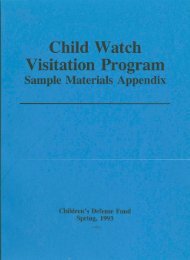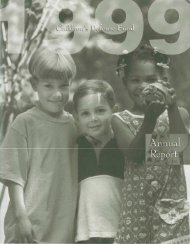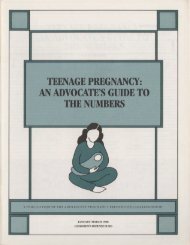children out of school in america - University of Tennessee Digital ...
children out of school in america - University of Tennessee Digital ...
children out of school in america - University of Tennessee Digital ...
Create successful ePaper yourself
Turn your PDF publications into a flip-book with our unique Google optimized e-Paper software.
certificate, high <strong>school</strong> diploma, or a college, university<br />
or pr<strong>of</strong>essional degree.. Persons <strong>in</strong> custodial<br />
day care centers (with little or no <strong>in</strong>structional programs),<br />
<strong>in</strong> specialized vocational, trade or bus<strong>in</strong>ess<br />
<strong>school</strong>, <strong>in</strong> on-the-job tra<strong>in</strong><strong>in</strong>g, or <strong>in</strong> correspondence<br />
courses (unless credits are transferable to "regular"<br />
<strong>school</strong>) are not counted as enrolled even though<br />
they may be considered to be further<strong>in</strong>g their education.<br />
As a result the Census data may overstate the<br />
number <strong>of</strong> <strong>children</strong> not "enrolled" to some extent.<br />
At the same time, it understates the "attendance"<br />
problem. Those who either attend <strong>in</strong>frequently but<br />
regularly (l or 2 days a week, every other week, etc.)<br />
or those who attend but whose "special" needs are<br />
so unmet by programs that attendance is virtually<br />
mean<strong>in</strong>gless are not counted. These <strong>children</strong> should<br />
be considered <strong>out</strong> <strong>of</strong> <strong>school</strong> even though they may<br />
have "attended" dur<strong>in</strong>g the previous two or three<br />
months.<br />
The Census data, with<strong>in</strong> its limitations, is helpful<br />
<strong>in</strong> quantify<strong>in</strong>g the extent <strong>of</strong> the problem and <strong>in</strong> identify<strong>in</strong>g<br />
some <strong>of</strong> the characteristics <strong>of</strong> <strong>children</strong> <strong>out</strong> <strong>of</strong><br />
<strong>school</strong>.<br />
Children Not Enrolled By State<br />
(Appendix E, Tables I, II and III)<br />
All data are derived from State Summary volumes<br />
<strong>of</strong> the U.S. Census <strong>of</strong> Population, 1970, four volumes<br />
per state, lettered A through D, with tables<br />
numbered consecutively through the volumes. We<br />
will refer to the table number, not to the particular<br />
volume <strong>in</strong> which it is conta<strong>in</strong>ed.<br />
person toward an elementary <strong>school</strong> certificate or high<br />
<strong>school</strong> diploma, or a college, university, or pr<strong>of</strong>essional<br />
degree. School<strong>in</strong>g that was not obta<strong>in</strong>ed <strong>in</strong> a regular<br />
<strong>school</strong> and <strong>school</strong><strong>in</strong>g from a tutor or through corre·<br />
spondence courses were counted .only if the credits ob·<br />
ta<strong>in</strong>ed were regarded as transferable to a <strong>school</strong> <strong>in</strong> the<br />
regular <strong>school</strong> system. Persons were <strong>in</strong>cluded as enrolled<br />
<strong>in</strong> nursery <strong>school</strong> only if the <strong>school</strong> <strong>in</strong>cluded <strong>in</strong>struction<br />
as an important and <strong>in</strong>tegral phase <strong>of</strong> its program. Chil·<br />
dren enrolled <strong>in</strong> "Head Start" programs, or similar programs<br />
sponsored by local agencies to provide pre<strong>school</strong><br />
education to young <strong>children</strong>, are <strong>in</strong>clUded as enrolled <strong>in</strong><br />
<strong>school</strong>s. Persons who had been enrolled <strong>in</strong> a regular <strong>school</strong><br />
s<strong>in</strong>ce February 1, 1970, but who had not actually attended,<br />
for example because <strong>of</strong> illness, were counted as enrolled<br />
<strong>in</strong> <strong>school</strong>.<br />
Persons were excluded from the enrollment figures if<br />
the only <strong>school</strong>s they had been attend<strong>in</strong>g at any time s<strong>in</strong>ce<br />
February 1, 1970, were IlOt "regular" (unless courses taken<br />
Children Not Enrolled<br />
Source. Table 146--Year <strong>of</strong> School <strong>in</strong> Which<br />
Enrolled for Persons 3-34 Years Old by Race, Type<br />
<strong>of</strong> School, Sex and Age.<br />
Procedure. Data given <strong>in</strong>clude the number and<br />
percentage <strong>of</strong> <strong>children</strong> enrolled by sex and age. To<br />
derive the number <strong>out</strong> <strong>of</strong> <strong>school</strong>, we first calculated<br />
the total number <strong>of</strong> <strong>children</strong> for each age:<br />
T I<br />
Number enrolled<br />
ota = -------<br />
Percentage enrolled<br />
and then determ<strong>in</strong>ed the grand total for the age<br />
group<strong>in</strong>gs (66 , 7-15, 16 & 17). Enrollment data<br />
were then totaled for the age group<strong>in</strong>gs and subtracted<br />
from total population figures to determ<strong>in</strong>e<br />
the number <strong>of</strong> <strong>children</strong> not enrolled <strong>in</strong> each age<br />
group<strong>in</strong>g.<br />
Note: Although Table 19 does show the total<br />
population by age, that is a total enumeration. The<br />
data <strong>in</strong> Table 146 came from a 15 percent sample<br />
<strong>of</strong> households. The total implied by the sample is<br />
not usually the same as that which we know to be<br />
the correct total, but it was the one used to calculate<br />
the percentages and to project the number enrolled.<br />
Therefore, the obvious procedure <strong>of</strong> subtract<strong>in</strong>g the<br />
number <strong>in</strong> <strong>school</strong> (Table 146) from the population<br />
(Table 19) would have been <strong>in</strong>consistent.<br />
Not Enrolled (Adjusted)<br />
Source. Table 154-Persons <strong>in</strong> Group Quarters<br />
by Type <strong>of</strong> Quarters, Sex, Race and Age.<br />
Procedure. Data is given separately for males<br />
and females, and by age categories: 5-13 years, 14<br />
and 15, and 16 and 17 years. "Inmates <strong>of</strong> Institutions"<br />
(for each sex) constitute six columns <strong>of</strong><br />
the table: "Mental Hospital," "Home for the Aged,"<br />
and "Other Inmate."<br />
Children liv<strong>in</strong>g <strong>in</strong> <strong>in</strong>stitutions are counted as enrolled<br />
or not enrolled accord<strong>in</strong>g to Census def<strong>in</strong>ition.<br />
However, these breakdowns are only published nationally<br />
and are not available by state. Because<br />
at such 3Chools could have been counted for credit at a<br />
regular <strong>school</strong>). School<strong>in</strong>g which is generally regarded as<br />
/lot "regular" <strong>in</strong>cludes that given <strong>in</strong> nursery <strong>school</strong>s which<br />
simply provide custodial day care; <strong>in</strong> specialized vocational,<br />
trade, or ·bus<strong>in</strong>ess <strong>school</strong>s; <strong>in</strong> on-the-job tra<strong>in</strong><strong>in</strong>g; and<br />
through correspondence courses.<br />
6 Data is shown on 6 year olds for target area states, but<br />
it is not counted <strong>in</strong> state or grand totals.<br />
153














